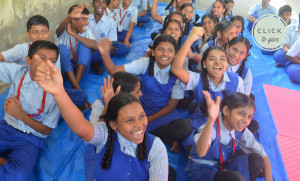March 21, 2016 is the 11th annual World Down Syndrome Day, a day to spread awareness about the “rights, inclusion and wellbeing of people with Down Syndrome.”
One of the biggest barriers to inclusion is special education access for children with disabilities. Especially in densely populated urban areas. So how do we work towards individualizing education and catering to children of all learning levels, including those with disabilities, in these parts of the world?
India, a land of contrasts, offers a good example of customizable education powered by nonprofits. There are estimated to be more than five million children with disabilities in the country, many of whom fall between the cracks of government provided education. But nonprofits like ‘Save the Children India’ (not to be confused with the international organization of the same name,) have made impressive headway towards filling this gap.
Dr. Subhadra Anand is Save the Children India’ CEO and oversees its impact on over 20,000 beneficiaries each year, many of whom have developmental disabilities.
“We know what we want to do and that is to really make the life of these children,” said Anand. “So that they don’t become a burden on their family. But they become an asset, and earning members. So they also live a life of dignity.”
In addition to education, health and vocational training programs, she is particularly proud of their ‘special care center.’ The center focuses on providing quality education for students who have developmental disabilities and who suffer from hearing impairment. There is now an early intervention program for the latter so these kids have a chance to learn communicative skills in their early years, when these skills are easier to harness.
“We are taking in children who are three to four years and we try to give them oral communication because our mission now is to make them talk,” Anand said.
The staff provides audiology testing and therapy, and the center now helps fund cochlear implants that can truly transform the lives of recipients. One therapist has been working with a 7-year-old boy who received the implant, and now is able to have basic conversations in English and in Hindi. She is very proud that he can converse in two languages.
Specialized education, however, is only one piece of the pie. Broadening the scope of general education access in India is another. E-learning is making huge strides in this arena for rural children, but there are countless children in the slums who need access as well. Nonprofit-sponsored slum schools are springing up in response to this need, like the Art of Living School in India’s largest slum Dharavi. But with an estimated one million people living in this slum alone, the need is great and there is a long way to go. But, the cost is relatively low.
The cost of educating a disadvantaged student in these programs starts at only a few cents per day, and many of the contributions required to stay sustainable come from individuals and small businesses. Organizations like Buy1GIVE1 play a significant role, and business partners are impressed with the results.
“The way they are doing things [at Save the Children India]—they’re solving problems by actually using common sense and using tried and tested methods that work,” said B1G1 business partner Jane Burns (who also regularly works in this sector). “What I’m seeing here is what I think are happier children because everyone is just getting in and doing it for the kids.”
There is immense value in having these programs run by people on the ground, who know where the needs are greatest and how to most effectively work towards resolving them. Because total educational access, plus specialization, is a daunting task in massively complex places like India. And it requires the knowledge and passion of those closest to it.
Save the Children India has helped over 200,000 children since its inception in 1988. They also offer resources for victims of human trafficking, and young slum children who have nowhere else to go. To contribute to Save the Children India, or any of B1G1’s other education causes, simply click on the project and enter the amount you wish to give! You’ll see how even a small contribution can create tangible impacts, on the lives of these incredible children.
Tracy Oppenheimer joined B1G1 at the beginning of 2016 to oversee creative content, and produce videos to showcase the amazing things B1G1 & its partners are doing. Buy1GIVE1 is an initiative that provides small to medium sized businesses the tools to implement a culture of regular philanthropic giving to our network of accountable worldwide nonprofits.


